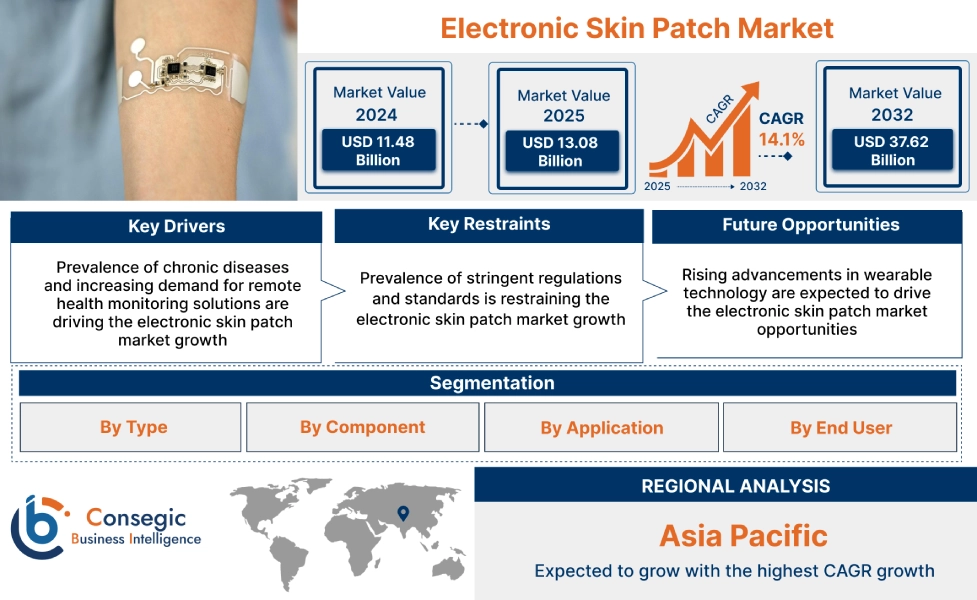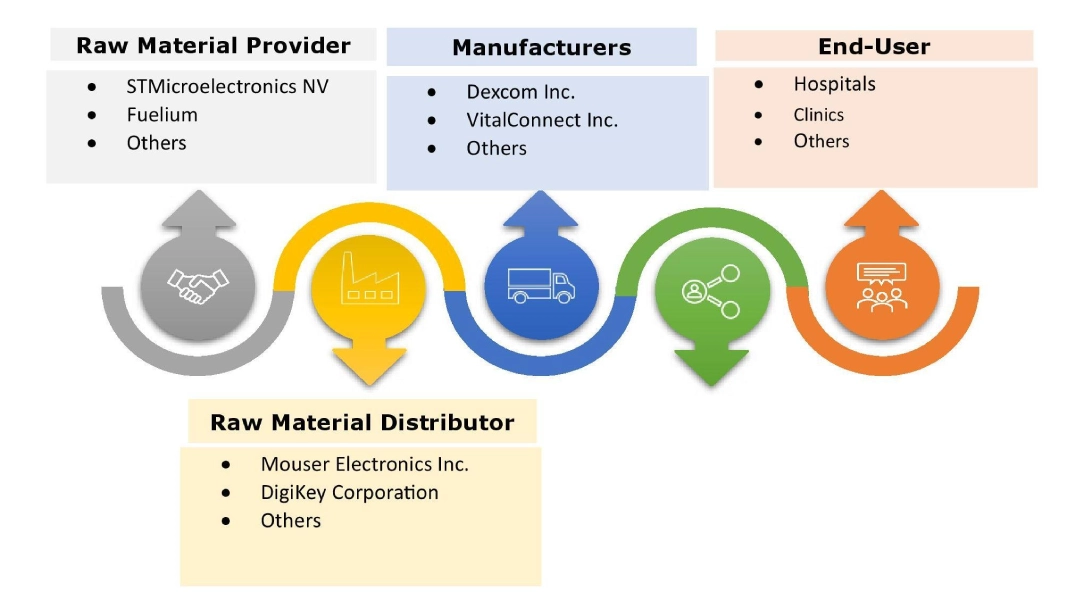Electronic Skin Patch Market Size:
Electronic Skin Patch Market size is estimated to reach over USD 37.62 Billion by 2032 from a value of USD 11.48 Billion in 2024 and is projected to grow by USD 13.08 Billion in 2025, growing at a CAGR of 14.1% from 2025 to 2032.
Electronic Skin Patch Market Scope & Overview:
An electronic skin patch, also known as an e-skin patch, refers to a wearable sensor that adheres to the skin and monitors various physiological parameters. E-skin patches are designed to be thin, flexible, and conformable, which enables comfortable and unobtrusive wear while accurately sensing and transmitting data wirelessly. These patches are increasingly used in healthcare for remote patient monitoring, particularly for conditions such as diabetes and cardiovascular diseases, along with other applications, including drug delivery and electrical stimulation, among others.
How is AI Transforming the Electronic Skin Patch Market?
The integration of AI is significantly transforming the electronic skin patch market. AI integration helps in enhancing functionality and facilitating personalized healthcare, and expanding applications beyond traditional monitoring. Moreover, AI-powered solutions can analyze biometric data from the e-skin patches, providing real-time diagnostics and actionable insights, including predictive healthcare and customized treatments.
Additionally, the integration of AI and e-skin patches is transforming healthcare and other fields by creating more efficient, personalized, and proactive solutions. Hence, the aforementioned factors are expected to positively impact the market growth in the upcoming years.
Electronic Skin Patch Market Dynamics - (DRO) :
Key Drivers:
Prevalence of chronic diseases and increasing demand for remote health monitoring solutions are driving the electronic skin patch market growth
The growing incidence of chronic diseases such as diabetes, cardiovascular issues, and respiratory problems is increasing the need for continuous health monitoring and management solutions. Electronic skin patches facilitate remote patient monitoring, which enables healthcare providers to track patients’ vital signs and other health data in real-time, even when they are not physically present. This plays a vital role in managing chronic conditions, as it enables early detection of potential problems and enables timely interventions. Additionally, the growing adoption of telehealth and digital health platforms is further fueling the demand for e-skin patches.
- For instance, according to the International Diabetes Federation, approximately 589 million adults (ranging between 20-79 years) worldwide are living with diabetes as of 2024, while the total number of individuals living with diabetes is expected to increase up to 853 million by 2050.
Thus, the growing prevalence of chronic diseases such as diabetes and others, along with the increasing need for continuous health monitoring and management solutions are driving the electronic skin patch market size.
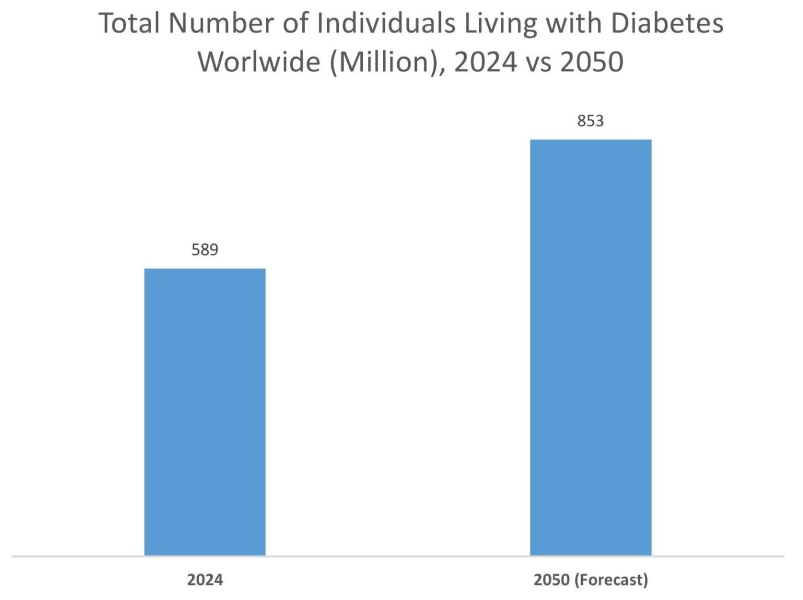
Key Restraints :
Prevalence of stringent regulations and standards is restraining the electronic skin patch market growth
E-skin patch manufacturers have to comply with numerous stringent standards associated with e-skin patches, which is a prime factor restricting the market growth. For instance, e-skin patch manufacturers have to comply with various standards such as the International Organization for Standardization: ISO 13485, CE (Conformité Européenne), and others.
ISO 13485 is a globally recognized standard for quality management systems, specifically for medical devices. This standard ensures that organizations that are involved in the design, production, installation, or servicing of medical devices, including electronic skin patches, meet rigorous regulatory requirements and consistently deliver safe and effective products. Additionally, CE marking signifies compliance of e-skin patches with European Union safety, health, and environmental protection standards. The CE mark is crucial for electronic skin patches intended for medical use, as it allows them to be marketed and sold within the European Economic Area. Thus, the prevalence of the aforementioned standards associated with e-skin patches is hindering the electronic skin patch market expansion.
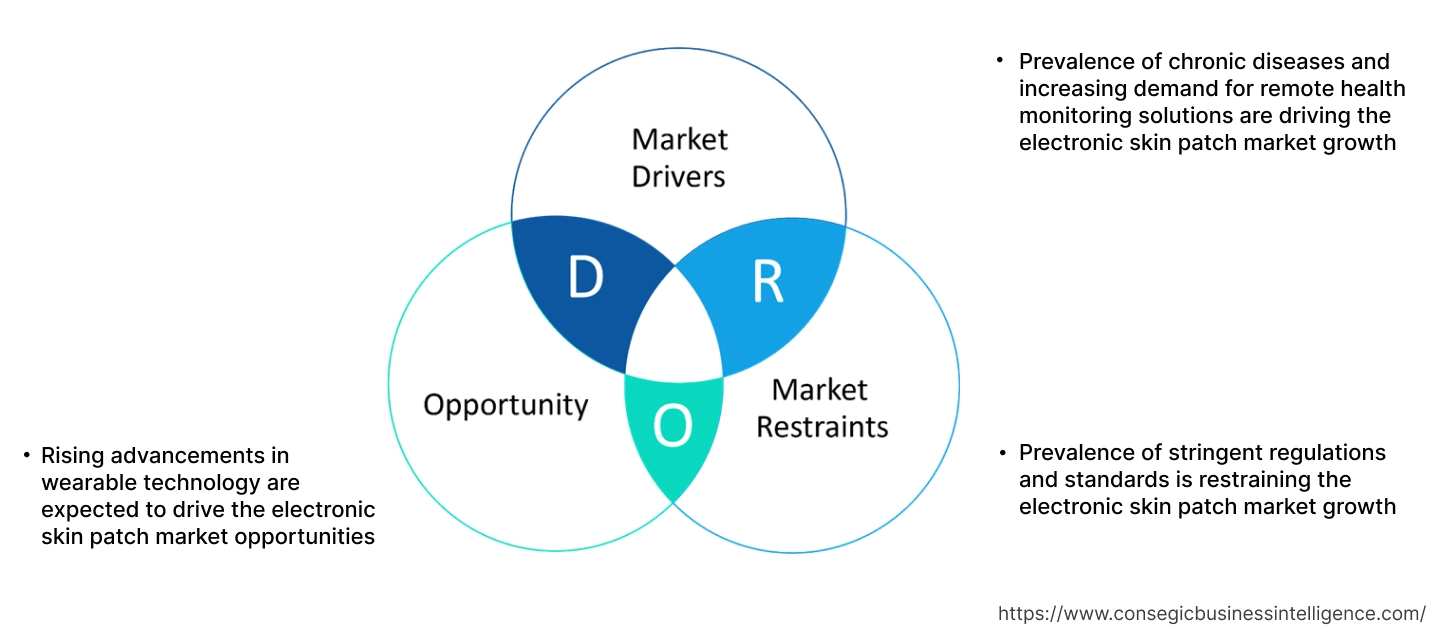
Future Opportunities :
Rising advancements in wearable technology are expected to drive the electronic skin patch market opportunities
The rising advancements in wearable technology, particularly flexible electronics, sensors, and wireless communication, are key aspects expected to drive the market. E-skin patches, which are designed to mimic human skin, offer continuous, non-invasive health monitoring, and they are witnessing increased adoption in the healthcare industry. Moreover, companies are constantly investing in the development of wearable technologies to ensure safe and efficient use of e-skin patches for remote health monitoring and management applications. As a result, companies are launching new products with updated features, which is further projected to propel the market growth.
- For instance, in November 2024, Henkel announced a collaboration with Linxens, with the aim of driving the integration of advanced technologies for medical wearables based on printed electronics. Moreover, printed electronicsenable the manufacturing of flexible circuits screen printed on flexible foils, which can be converted into a self-adhesive tape, and further cut into the shape of a skin patch. The company’s heating skin patch can be utilized in several wellness and healthcare applications, including pain relief and temperature-controlled drug delivery.
Hence, according to the analysis, the rising advancements in medical wearable technology are projected to boost the electronic skin patch market opportunities during the forecast period.
Electronic Skin Patch Market Segmental Analysis :
By Product Type:
Based on product type, the market is segmented into monitoring & diagnostic patches, therapeutic/drug delivery patches, and others.
Trends in the product type:
- Increasing trend in adoption of monitoring & diagnostic e-skin patches in telemedicine, personalized healthcare, and home healthcare settings to facilitate early diagnosis, preventive care, and remote patient monitoring is driving the market.
- Factors including the rise of chronic diseases, advancements in wearable sensor technology, and growing need for personalized drug delivery solutions are key prospects driving the adoption of therapeutic/drug delivery patches.
The monitoring & diagnostic patches segment accounted for a substantial revenue share in the electronic skin patch market share in 2024.
- Monitoring & diagnostic e-skin patches are flexible, wearable devices that can continuously track various health indicators, which offer a convenient and non-invasive approach to monitor physiological data in real-time.
- Moreover, these patches incorporate sensors to measure parameters such as heart activity, temperature, glucose, muscle movement, and even chemical markers in sweat.
- Additionally, monitoring & diagnostic e-skin patches are increasingly used in telemedicine, personalized healthcare, and home healthcare settings to facilitate early diagnosis, preventive care, and remote patient monitoring.
- For instance, VitalConnect Inc. offers VitalPatch RTM in its product offering, which is an electronic skin patch that is specifically designed for cardiac monitoring applications. It is designed for measuring key vital signs, including a live ECG, which enables physicians to monitor their patients while they recover at home.
- According to the electronic skin patch market analysis, the increasing advancements associated with monitoring & diagnostic e-skin patches are further driving the market.
The therapeutic/drug delivery patches segment is anticipated to register the fastest CAGR during the forecast period.
- Therapeutic/drug delivery e-skin patches are flexible, wearable devices that integrate electronic components with drug delivery systems, which further enable the controlled release of therapeutic agents directly onto or through the skin.
- These patches combine the capabilities of electronic skin (e-skin) for monitoring and sensing with traditional transdermal drug delivery (TDD) methods, offering an advanced approach to personalized and localized drug therapy.
- In addition, factors including the rise of chronic diseases, advancements in wearable sensor technology, and growing need for personalized drug delivery solutions are key prospects driving the segment.
- According to the market analysis, the aforementioned factors are expected to drive the electronic skin patch market size during the forecast period.
By Component:
Based on component, the market is segmented into sensors, signal processing units, batteries, communication modules, and others.
Trends in the component:
- Rising advancements associated with wearable sensor technology to monitor a range of physiological data, such as cardiovascular monitoring, temperature monitoring, and others, are driving the market.
- Increasing adoption of batteries in e-skin patches and rising technological innovations related to batteries, such as sweat-activated batteries and stretchable batteries, are propelling the market.
The sensors segment accounted for the largest revenue in the overall electronic skin patch market share in 2024.
- E-skin patches utilize various sensors to monitor a range of physiological data and conditions.
- These sensors are often integrated with flexible and stretchable materials and they enable non-invasive, real-time monitoring of vital signs, movement, and even biological markers.
- Moreover, the most commonly used sensors in e-skin patches includethermal sensors, electrical sensors, pressure sensors, and electrochemical sensors, among others.
- Thermal sensors are used to monitor skin temperature, providing data regarding body temperature fluctuations.
- Additionally, electrical sensors detect electrical signals generated by the nervous system, such as electrocardiography (ECG) signals, which are crucial for monitoring heart activity.
- Therefore, increasing advancements related to sensors used in e-skin patches are driving the electronic skin patch market trends.
The batteries segment is anticipated to register a substantial CAGR during the forecast period.
- E-skin patches utilize various types of batteries to power their sensors, microelectronics, and wireless communication modules.
- Moreover, common battery types include traditional coin cell batteries, laminated batteries, and emerging technologies such as sweat-activated batteries and stretchable batteries.
- For instance, Fueliumoffers flexible and conformal laminated batteries in its product portfolio, which are designed to provide a distinct combination of high power density and sustainability. This facilitates the utilization of these batteries in high-power demanding applications along with the miniaturization of the e-skin patches.
- Hence, the increasing developments associated with batteries for use in e-skin patches areprojected to boost the market during the forecast period.
By Application:
Based on application, the market is segmented into diabetes monitoring & management, cardiovascular monitoring, temperature monitoring, drug delivery, and others.
Trends in the application:
- Factors including an increasing elderly population and rising incidence of diabetes, driven by factors such as pre-existing health conditions, hormonal changes, and lifestyle choices, are among the key aspects driving the adoption of e-skin patches for diabetes monitoring & management.
- Factors including rising prevalence of cardiovascular diseases, increasing adoption of remote patient monitoring, and technological advancements in wearable devices are among the primary aspects driving the cardiovascular monitoring segment.
The diabetes monitoring & management segment accounted for the largest revenue in the overall market in 2024, and it is anticipated to register a substantial CAGR during the forecast period.
- E-skin patches are primarily used for diabetes monitoring and management applications, offering continuous, painless, and potentially real-time glucose level tracking, along with integrated drug delivery capabilities.
- Moreover, e-skin patches can replace traditional finger-prick methods for diabetes monitoring, in turn providing a more comfortable and convenient approach for individuals with diabetes to manage their condition.
- Additionally, e-skin patches that are specifically designed for diabetes monitoring and management often incorporate continuous glucose monitoring (CGM) technology, which enables real-time tracking of glucose levels, potentially improving diabetes control and reducing the risk of complications.
- For instance, Dexcom Inc. offers Dexcom G7 electronic skin patches that are specifically designed for continuous glucose monitoring. The patches are waterproof, long-lasting, and provide a secure fit, allowing users to confidently engage in daily activities.
- Therefore, increasing adoption of e-skin patches for diabetes monitoring and management applications is driving the market.
By End User:
Based on the end user, the market is segmented into hospitals & clinics, home healthcare, and others.
Trends in the end user:
- There is a rising trend towards the adoption of e-skin patches in hospitals and clinics for diagnostics, patient monitoring, and acute care settings, where clinical validation and healthcare professional oversight are essential.
- Increasing emphasis on patient-centric care, rising digital and remote patient monitoring solutions, and the ongoing transition to managing chronic conditions in home-based settings are driving the home healthcare segment.
The hospitals & clinics segment accounted for the largest revenue share of 51.54% in the market in 2024.
- E-skin patches are primarily used in hospitals and clinics for facilitating continuous, non-invasive patient monitoring.
- Moreover, e-skin patches can track vital signs, metabolic markers, and other health indicators, which enables remote patient monitoring, early detection of health issues, and personalized healthcare.
- E-skin patches can also assist in managing conditions such as diabetes (glucose monitoring), hypertension, and heart failure by providing real-time data on patient status.
- Additionally, e-skin patches can be used to monitor patients' recovery progress after surgery, providing valuable data for healthcare professionals.
- Hence, the rising adoption of e-skin patches in hospitals and clinicsis driving the market growth.
The home healthcare segment is anticipated to register the fastest CAGR during the forecast period.
- E-skin patches are transforming home healthcare by allowing continuous, non-invasive monitoring of various health parameters.
- E-skin patches can track vital signs such as heart rate, respiration rate, and temperature, as well as biomarkerssuch as glucose and others, which offer detailed insights into a patient's health status.
- Moreover, e-skin patches are particularly useful for remote patient monitoring, allowing individuals to receive care at home while still being closely monitored by healthcare professionals.
- Further, factors such as increasing emphasis on patient-centric care, rising digital and remote patient monitoring solutions, along with the ongoing transition to managing chronic conditions in home-based settings are driving the home healthcare segment
- Consequently, the above factors areexpected to drive the market growth during the forecast period.
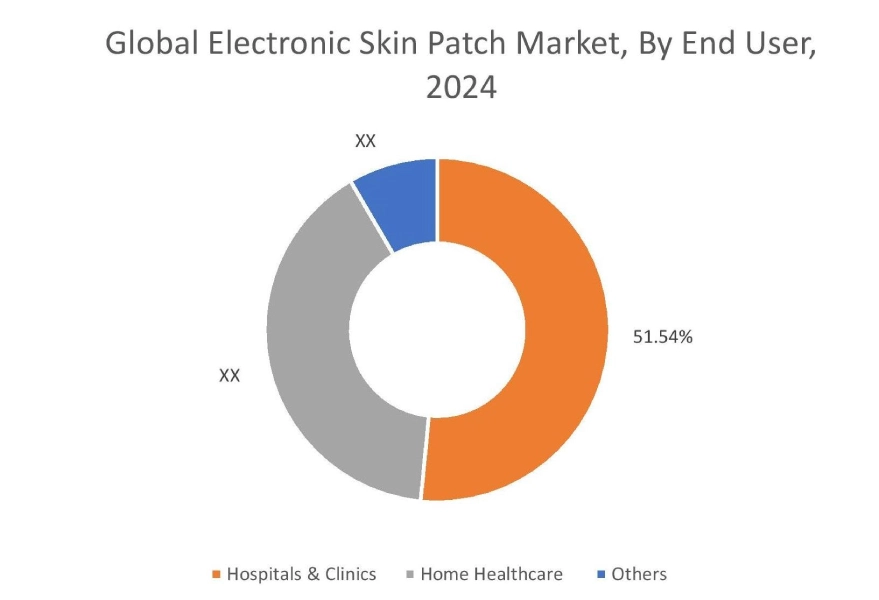
Regional Analysis:
The regions covered are North America, Europe, Asia Pacific, the Middle East and Africa, and Latin America.
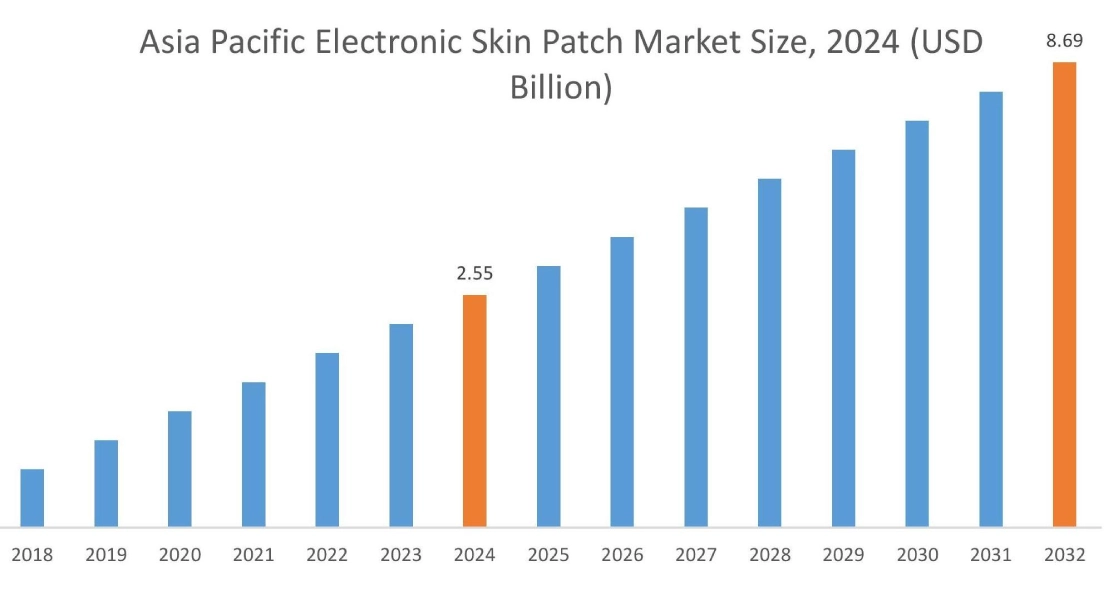
Asia Pacific region was valued at USD 2.55 Billion in 2024. Moreover, it is projected to grow by USD 2.91 Billion in 2025 and reach over USD 8.69 Billion by 2032. Out of this, China accounted for the maximum revenue share of 33.25%. As per the electronic skin patch market analysis, the adoption of e-skin patches in the Asia-Pacific region is primarily by the rising prevalence of chronic diseases such as diabetes and cardiovascular diseases along with increasing awareness and emphasis on remote health monitoring solutions. Similarly, the rising technological advancements associated with wearable solutions for blood sugar monitoring and management are further accelerating the electronic skin patch market expansion.
- For instance, according to the International Diabetes Federation, the number of adults (20–79 years) with diabetes in India reached up to 89.8 million in 2024. The above factors are further driving the market in the Asia-Pacific region.
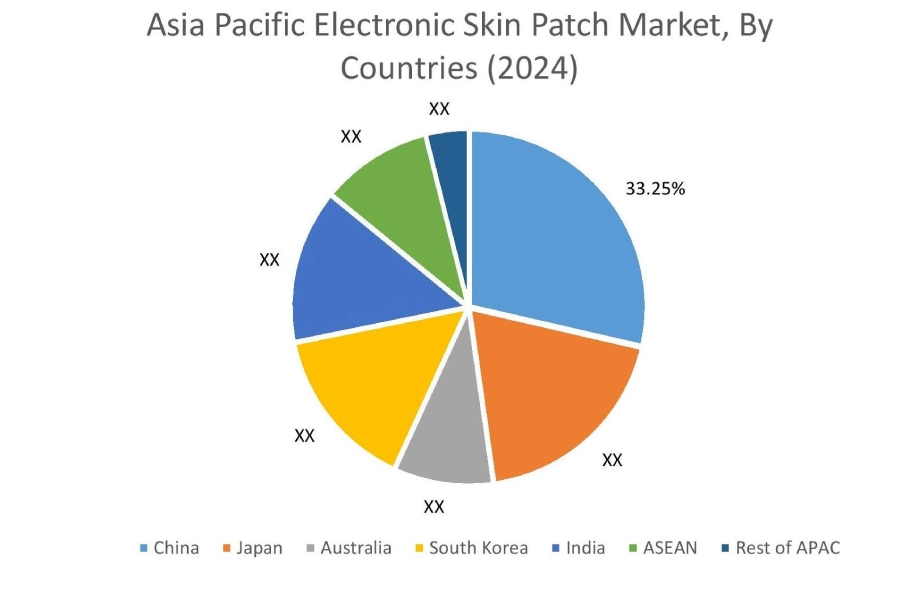
North America is estimated to reach over USD 14.97 Billion by 2032 from a value of USD 4.61 Billion in 2024 and is projected to grow by USD 5.25 Billion in 2025. In North America, the growth of the electronic skin patch industry is driven by the increasing prevalence of diabetes, particularly Type 2 diabetes, along with rising cases of cardiovascular diseases, caused by factors such as urbanization, changing lifestyles, and rising obesity rates. Additionally, increasing awareness regarding home care remote monitoring solutions and improving healthcare infrastructure and services are further contributing to the electronic skin patch market demand.
- For instance, according to the U.S Centers for Disease Control and Prevention, approximately 1 in 20 adults, aged 20 and older, have cardiovascular disease in the United States. The above factors are expected to propel the electronic skin patch market trends in North America during the forecast period.
Meanwhile, according to the regional analysis, factors including the prevalence of elderly population, strong emphasis on preventive healthcare, and robust healthcare infrastructure are driving the electronic skin patch market demand in Europe. Furthermore, according to the market analysis, the market demand in Latin America, Middle East, and African regions is expected to grow at a considerable rate due to factors such as increasing prevalence of diabetes, cardiovascular diseases, and other chronic conditions, combined with the growing awareness regarding remote health monitoring and management solutions among others, among others.
Top Key Players & Market Share Insights:
The global electronic skin patch market is highly competitive with major players providing products to the national and international markets. Key players are adopting several strategies in research and development (R&D), product innovation, and end-user launches to hold a strong position in the electronic skin patch market. Key players in the electronic skin patch industry include-
- Abbott(U.S)
- Dexcom Inc.(U.S)
- Biolinq Incorporated (U.S)
- VivaLNK Inc. (U.S)
- GE Healthcare (U.S)
- VitalConnect Inc.(U.S)
- iRhythm Technologies Inc. (U.S)
- Leaf Healthcare Inc. (U.S)
- Sensium Healthcare Ltd. (United Kingdom)
- Koninklijke Philips N.V. (Netherlands)
Recent Industry Developments :
Partnerships & Collaborations:
- In November 2024, Henkel announced a partnership with Linxens, with the aim of driving the integration of advanced technologies for medical wearables based on printed electronics. Moreover, the company demonstrated a heating skin patch, which can be utilized in several wellness and healthcare applications, including pain relief and temperature-controlled drug delivery.
Electronic Skin Patch Market Report Insights :
| Report Attributes | Report Details |
| Study Timeline | 2019-2032 |
| Market Size in 2032 | USD 37.62 Billion |
| CAGR (2025-2032) | 14.1% |
| By Type |
|
| By Component |
|
| By Application |
|
| By End User |
|
| By Region |
|
| Key Players |
|
| North America | U.S. Canada Mexico |
| Europe | U.K. Germany France Spain Italy Russia Benelux Rest of Europe |
| APAC | China South Korea Japan India Australia ASEAN Rest of Asia-Pacific |
| Middle East and Africa | GCC Turkey South Africa Rest of MEA |
| LATAM | Brazil Argentina Chile Rest of LATAM |
| Report Coverage |
|
Key Questions Answered in the Report
How big is the electronic skin patch market? +
The electronic skin patch market was valued at USD 11.48 Billion in 2024 and is projected to grow to USD 37.62 Billion by 2032.
Which is the fastest-growing region in the electronic skin patch market? +
Asia-Pacific is the region experiencing the most rapid growth in the electronic skin patch market.
What specific segmentation details are covered in the electronic skin patch report? +
The electronic skin patch report includes specific segmentation details for type, component, application, end user, and region.
Who are the major players in the electronic skin patch market? +
The key participants in the electronic skin patch market are Abbott (U.S), Dexcom Inc. (U.S), VitalConnect Inc. (U.S), iRhythm Technologies Inc. (U.S), Leaf Healthcare Inc. (U.S), Sensium Healthcare Ltd. (United Kingdom), Koninklijke Philips N.V. (Netherlands), Biolinq Incorporated (U.S), VivaLNK Inc. (U.S), GE Healthcare (U.S), and others.
